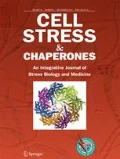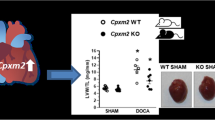Abstract
5-Hydroxytryptamine receptor 2A (HTR2A) is a central regulator of fetal brain development and cognitive function in adults. However, the roles of HTR2A in the cardiovascular system are not fully understood. Here in this study, we explored the function of HTR2A in cardiac hypertrophy. Significantly, the expression levels of HTR2A mRNA and protein levels were upregulated in hypertrophic hearts of human patients. Besides, the expression of HTR2A was also upregulated in isoproterenol (ISO)-induced cardiac hypertrophy in the mouse. Next, the expression of HTR2A was knocked down with shRNA or overexpressed with adenovirus in neonatal rat cardiomyocytes, and ISO was used to induce cardiomyocyte hypertrophy. We showed that HTR2A knockdown repressed ISO-induced cardiomyocyte hypertrophy, which was demonstrated by decreased cardiomyocyte size and repressed expression of hypertrophic fetal genes (e.g., myosin heavy chain beta (β-Mhc), atrial natriuretic peptide (Anp), and brain natriuretic peptide (Bnp)). By contrast, HTR2A overexpression promoted cardiomyocyte hypertrophy. Of note, we observed that HTR2A promoted the activation (phosphorylation) of AKT-mTOR (mammalian target of rapamycin) signaling in cardiomyocytes, and repression of AKT-mTOR with perifosine or rapamycin blocked the effects of HTR2A on cardiomyocyte hypertrophy. Finally, we showed that HTR2A regulated AKT-mTOR signaling through activating the PI3K-PDK1 pathway, and inhibition of either PI3K or PDK1 blocked the roles of HTR2A in regulating AKT-mTOR signaling and cardiomyocyte hypertrophy. Altogether, these findings demonstrated that HTR2A activated PI3K-PDK1-AKT-mTOR signaling and promoted cardiac hypertrophy.





Similar content being viewed by others
References
Aoyagi T, Matsui T (2011) Phosphoinositide-3 kinase signaling in cardiac hypertrophy and heart failure. Curr Pharm Des 17:1818–1824
Ayme-Dietrich E, Marzak H, Lawson R, Mokni W, Wendling O, Combe R, Becker J, El Fertak L, Champy MF, Matz R, Andriantsitohaina R, Doly S, Boutourlinsky K, Maroteaux L, Monassier L (2015) Contribution of serotonin to cardiac remodeling associated with hypertensive diastolic ventricular dysfunction in rats. J Hypertens 33:2310–2321
L. Cai, G. Fan, F. Wang, S. Liu, T. Li, X. Cong, J. Chun, X. Chen,(2017) Protective role for LPA3 in cardiac hypertrophy induced by myocardial infarction but not by isoproterenol, Front. Physiol., 8.
Chen X-F, Chen X, Tang X (2020) Short-chain fatty acid, acylation and cardiovascular diseases. Clin Sci 134:657–676
Choi JR, Jeon M, Koh SB (2020) Association between serotonin 2A receptor (HTR2A) genetic variations and risk of hypertension in a community-based cohort study. BMC Med Genet 21:5
Edinger AL, Thompson CB (2002) Akt maintains cell size and survival by increasing mTOR-dependent nutrient uptake. Mol Biol Cell 13:2276–2288
Genis-Mendoza AD, Ruiz-Ramos D, Lopez-Narvaez ML, Tovilla-Zarate CA, Rosa Garcia A, Cortes Meda G, Martinez-Magana JJ, Gonzalez-Castro TB, Juarez-Rojop IE, Nicolini H (2019) Genetic association analysis of 5-HTR2A gene variants in eating disorders in a Mexican population. Brain Behav 9:e01286
Gong H, Tai H, Huang N, Xiao P, Mo C, Wang X, Han X, Zhou J, Chen H, Tang X, Zhao T, Xu W, Gong C, Zhang G, Yang Y, Wang S, Xiao H (2020) Nrf2-SHP cascade-mediated STAT3 inactivation contributes to AMPK-driven protection against endotoxic inflammation. Front Immunol 11:414
Halder I, Muldoon MF, Ferrell RE, Manuck SB (2007) Serotonin receptor 2A (HTR2A) gene polymorphisms are associated with blood pressure, central adiposity, and the metabolic syndrome. Metab Syndr Relat Disord 5:323–330
Hranilovic D, Blazevic S, Stefulj J, Zill P (2016) DNA methylation analysis of HTR2A regulatory region in leukocytes of autistic subjects. Autism Res 9:204–209
Jia Y-Y, Lu J, Huang Y, Liu G, Gao P, Wan Y-Z, Zhang R, Zhang Z-Q, Yang R-F, Tang X, Xu J, Wang X, Chen H-Z, Liu D-P (2014) The involvement of NFAT transcriptional activity suppression in SIRT1-mediated inhibition of COX-2 expression induced by PMA/ionomycin. PLoS One 9:e97999
Kemi OJ, Ceci M, Wisloff U, Grimaldi S, Gallo P, Smith GL, Condorelli G, Ellingsen O (2008) Activation or inactivation of cardiac Akt/mTOR signaling diverges physiological from pathological hypertrophy. J Cell Physiol 214:316–321
Lairez O, Cognet T, Schaak S, Calise D, Guilbeau-Frugier C, Parini A, Mialet-Perez J (2013) Role of serotonin 5-HT2A receptors in the development of cardiac hypertrophy in response to aortic constriction in mice. J Neural Transm (Vienna) 120:927–935
Lombaert N, Hennes M, Gilissen S, Schevenels G, Aerts L, Vanlaer R, Geenen L, Van Eeckhaut A, Smolders I, Nys J, Arckens L (2018) 5-HTR2A and 5-HTR3A but not 5-HTR1A antagonism impairs the cross-modal reactivation of deprived visual cortex in adulthood. Mol Brain 11:65
Luo Y-X, Tang X, An X-Z, Xie X-M, Chen X-F, Zhao X, Hao D-L, Chen H-Z, Liu D-P (2017) Sirt4 accelerates Ang II-induced pathological cardiac hypertrophy by inhibiting manganese superoxide dismutase activity. Eur Heart J 38:1389–1398
Nakamura M, Sadoshima J (2018) Mechanisms of physiological and pathological cardiac hypertrophy. Nat Rev Cardiol 15:387–407
Paquette AG, Marsit CJ (2014) The developmental basis of epigenetic regulation of HTR2A and psychiatric outcomes. J Cell Biochem 115:2065–2072
Paquette AG, Lesseur C, Armstrong DA, Koestler DC, Appleton AA, Lester BM, Marsit CJ (2013) Placental HTR2A methylation is associated with infant neurobehavioral outcomes. Epigenetics 8:796–801
Ren J, Sowers JR, Zhang Y (2018) Metabolic stress, autophagy, and cardiovascular aging: from pathophysiology to therapeutics. Trends Endocrinol Metab 29:699–711
Rohini A, Agrawal N, Koyani CN, Singh R (2010) Molecular targets and regulators of cardiac hypertrophy. Pharmacol Res 61:269–280
Sabolovic Rudman S, Mustapic M, Kosec V, Pivac N, Rudman F, Muck-Seler D (2015) Serotonin risk factors for the development of hypertension in pregnancy. Arch Gynecol Obstet 291:779–785
Sciarretta S, Forte M, Frati G, Sadoshima J (2018) New insights into the role of mTOR signaling in the cardiovascular system. Circ Res 122:489–505
Shende P, Xu L, Morandi C, Pentassuglia L, Heim P, Lebboukh S, Berthonneche C, Pedrazzini T, Kaufmann BA, Hall MN (2016) Cardiac mTOR complex 2 preserves ventricular function in pressure-overload hypertrophy. Cardiovasc Res 109:103–114
Shimizu I, Minamino T (2016) Physiological and pathological cardiac hypertrophy. J Mol Cell Cardiol 97:245–262
Tang X, Ma H, Han L, Zheng W, Lu Y-B, Chen X-F, Liang S-T, Wei G-H, Zhang Z-Q, Chen H-Z, Liu D-P (2016) SIRT1 deacetylates the cardiac transcription factor Nkx2.5 and inhibits its transcriptional activity. Sci Rep 6:36576
Tang X, Chen X-F, Chen H-Z, Liu D-P (2017) Mitochondrial Sirtuins in cardiometabolic diseases. Clin Sci 131:2063–2078
X. Tang, P.-H. Li, H.-Z. Chen,(2020) Cardiomyocyte senescence and cellular communications within myocardial microenvironment, Front. Endocrinol. (Lausanne).
Xu L, Brink M (2016) mTOR, cardiomyocytes and inflammation in cardiac hypertrophy. Biochimica et Biophysica Acta (BBA)-Molecular Cell Research 1863:1894–1903
Zhou S, Tang X, Chen HZ (2018) Sirtuins and insulin resistance. Front Endocrinol (Lausanne) 9:748
Author contributions
Weinian Gao and Shuguang Zhao designed the study and wrote the manuscript. Weinian Gao performed most of the experiments with help from Na Guo. Ziying Chen and Wenli Zhang collected human samples. Fang Yan and Hongjuan Liao performed the animal study. Kui Chi isolated cardiomyocytes.
Funding
This study was supported by the Health Commission of Hebei Province (20190058).
Author information
Authors and Affiliations
Corresponding author
Ethics declarations
Conflict of interest
The authors declare that they have no conflict of interest.
Ethics declarations
All animal experiments were performed according to the terms of the Animal Committee of Hebei Medical University (#2018-M051).
Ethical approval
Ethics approval for the collection of human samples was obtained from the Committee of Hebei Medical University (#2018-P047).
Informed consent
All the participants expressed informed consent.
Additional information
Publisher’s note
Springer Nature remains neutral with regard to jurisdictional claims in published maps and institutional affiliations.
Rights and permissions
About this article
Cite this article
Gao, W., Guo, N., Zhao, S. et al. HTR2A promotes the development of cardiac hypertrophy by activating PI3K-PDK1-AKT-mTOR signaling. Cell Stress and Chaperones 25, 899–908 (2020). https://doi.org/10.1007/s12192-020-01124-x
Received:
Revised:
Accepted:
Published:
Issue Date:
DOI: https://doi.org/10.1007/s12192-020-01124-x




